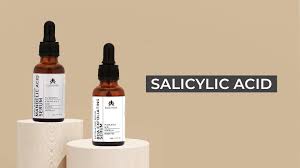Can You Use Benzoyl Peroxide After Salicylic Acid?
Salicylic acid and benzoyl peroxide are both well-known acne fighting ingredients. Both of which can be regularly found formulated in over the counter products as well as prescription blends. With a variety of skincare products available, you will find it an easy task to find the right formula for you and your skin.
However, with such potent ingredients, there are some common side effects connected to these powerhouse actives. Not to worry as we will cover this in today’s blog post, and with any luck, we will also answer the question, can you use benzoyl peroxide after salicylic acid?
Before we get into the nitty gritty, let’s first have a brief recap of these ingredients and the benefits they deliver to the skin.
What is benzoyl peroxide?
Benzoyl peroxide is the most potent and effective acne fighting ingredient. You’ll often find that it’s used as a prescription as many find this strength to be the most effective at combating any concerns with breakouts and blemishes, especially those that are large, red, and swollen. The way that benzoyl peroxide works differently to salicylic acid is the fact it combats the bacteria found on the skin that can form frequent breakouts and flare-ups in acne.
The main downside to using such a potent ingredient, is the risk of causing your skin some unwanted irritation, especially if you have a sensitive skin type. To avoid severe irritation, it is advised to not use benzoyl peroxide if you suffer from the following conditions, such as eczema, psoriasis, and seborrheic dermatitis. I suggest you consult with a doctor before introducing anything new into your skincare routine.
What is salicylic acid?
The most used beta hydroxy acid, BHA, salicylic acid is one of the most potent chemical exfoliants. Compared to other acids, it’s oil soluble and works deeply into the skin, reaching the bottom of the pores and unclogging them of excess sebum, dirt, bacteria, and other impurities.
Salicylic acid is proven to have the best results with whiteheads and blackheads. With continuous use you’ll find maintaining your skin clarity is easy and effective, thanks to the acid sloughing away dead skin cells, and ridding the skin of dirt and bacteria. The downside to this spot banishing acid is its tendency to cause itchiness, stinging, tingling, and peeling of the skin. You will also find that if overused or applied incorrectly, salicylic acid can strip the skin of all oil leaving it feeling uncomfortable and severely dry. This will lead to the skin overproducing sebum (the natural oil in the skin) which results in even more breakouts.
What goes on first benzoyl peroxide or salicylic acid?
The general rule of thumb when using skincare products is to start with the thinnest consistency and work your up to the thickest. This will determine which ingredient will be applied to the skin first. To keep your skin happy and healthy, it’s best to wait about 10-15 minutes in between applications as this allows the skin enough time to rebalance and the pH levels to settle, ready for the next step in your routine.
Another way of using both ingredients in your routine is alternating the time of day you apply them to your skin. Many users favour applying salicylic acid enriched toners during your morning routine, opting to follow this with benzoyl peroxide serums to work in the evening. Ideally, you’re better off using potent ingredients during your evening routine as there is less risk of them encountering free radical damage and exposure, such as exposure to UV rays and pollution.
Should I use salicylic acid before benzoyl peroxide?
Well, it’s down to your skincare product, as I have already mentioned about applying your skincare routine from thinnest to thickest consistency. It is considered safe to use salicylic acid before benzoyl peroxide, ensuring you are confident in applying them the correct way and have built a skin tolerance.
If you have any concerns, you aren’t sure of the best way of using your products, consult with a doctor or dermatologist. You can also check out our dedicated blog post about whether you should use benzoyl peroxide or salicylic acid first.
Can you use salicylic acid and benzoyl peroxide for acne?
Yes, absolutely! Both ingredients are highly effective at treating acne and many find teaming them together deliver impressive results.
You’ll often find that salicylic acid is the most used out of the two ingredients, due to it being more readily available in over-the-counter formulas. Benzoyl peroxide is often suggested my dermatologists to tackle mild to moderate acne and blemishes. For more severe acne teaming both ingredients are the ultimate power duo but is something that requires time and commitment. This is because you are at risk of stripping the skin of essential sebum and can cause extreme irritation, so ensure you build your skin’s tolerance to these ingredients. You can expect to start seeing improvements in your skin clarity after 2 months, but if you suffer from the smallest irritation, stop using your products and seek medical advice.
How long should I wait to apply moisturiser after benzoyl peroxide?
After applying products enriched in benzoyl peroxide, it’s best to wait for the product to absorb fully into the skin before using a moisturiser. For an added boost, it’s thought handy to opt for a moisturiser that contains a hydrating ingredient, such as hyaluronic acid to help lock moisture into place. You should also double check the moisturiser formula contains non-comedogenic ingredients as this would be counteractive. Instead, gel-based moisturisers will not only keep the skin hydrated, but you will also apply a physical barrier on the surface of the skin. This will help with extra protection for the skin preventing any free radicals, bacteria, and every day impurities absorbing into the skin.
Is salicylic acid or benzoyl peroxide better for hormonal acne?
When treating hormonal acne, benzoyl peroxide is considered the superior ingredient due to its ability to target, larger papules on the chin, cheek, and jawline. You will also find, that out of the two ingredients, benzoyl peroxide contains anti-bacterial, anti-inflammatory, and anti-microbial properties that salicylic acid is lacking. Benzoyl peroxide can work deeply in the skin by destroying any bacteria and excess sebum that can clog the pores and cause inflammation.
There you have a little more detail about using benzoyl peroxide and salicylic acid to combat acne. Don’t forget, if you have any further questions, come, and follow us on Instagram.
DQH Knowledge drop: In your 20s, your skin cell turnover decreases. (Cell turnover is a key component in keeping your skin youthful.) You know what else slows down? Your collagen production. Starting in your 20s, collagen decreases by about 1 percent per year. Should you want to prevent fine lines and wrinkles, start by eliminating behaviors that contribute to premature aging. “If it’s bad for you, it’s bad for your skin,” says dermatologist Michel Somenek.
“Cigarette smoking reduces blood flow to the skin and causes premature wrinkling and a dull skin texture. Making the repeated pursed motion to inhale can also cause smoker’s lines. Alcohol and recreational drugs are toxins for the skin that damage its cellular structure and DNA,” Somenek tells us. “The faster you eliminate vices while you are young, the better chance your skin and body have to recuperate.” Also, adopting an anti-aging routine in your 20s is key. After all, the best offense is a good defense. We spoke to Somenek and experts Joshua Ross and Audrey Kunin to find out more.
Keep reading for the best anti-aging products for your 20s, according to skincare professionals.
Sunscreen
“We all know that the sun is the number one cause of skin aging and starting the prevention in your 20s is very important,” Ross says. “The majority of your sun damage won’t start to appear until you’re in your 30s, so don’t wait until you see it surface or you’ll be behind the curve. Stay ahead of it with a good-quality zinc-based sunscreen worn daily.”
Farmacy Green Defense Daily Mineral Sunscreen
An invisible sunscreen with SPF 30, plus botanical extracts meant to protect skin with tons of antioxidants. Bonus: It’s clean and fine to use under makeup.
Bareminerals Complexion Rescue™ Tinted Moisturizer Broad Spectrum SPF 30
Although we recommend you use your SPF and moisturizer separately, we also understand moments when you don’t have time or energy for that extra step. For those times, this bareMinerals moisturizer is a great thing to have on hand.
Vitamin C Serum
“A great introduction to anti-aging is to start with a vitamin C serum in your morning skincare routine,” Ross says. “It’s a powerful antioxidant that will neutralize free radicals and brighten the skin.” He adds that it’s a great way to counteract the effects of the sun’s harmful rays, which, as previously mentioned, are among the biggest causes of premature aging.
Drunk Elephant C-Firma™ Vitamin C Day Serum
The Drunk Elephant C-Firma is a lightweight serum that promises to give skin a glow by combining the brightening powers of vitamin C with ferulic acid, l-ascorbic acid, and vitamin E. The included sodium hyaluronate is meant to replace hydration loss, so you shouldn’t have to deal with any irritation.
Sunday Riley C.E.O. Rapid Flash Brightening Serum
This potent serum is jam-packed with vitamin C (15 percent, to be exact), which means it’s a potential superstar at both brightening skin and dousing it in antioxidants.
Peptides
Using peptides on your skin has many benefits, says Somenek. “The skin barrier is what defends the body against pollution, UV rays, bacteria, and toxins. It can be damaged by several everyday factors. Using topical peptides aids in building a stronger barrier,” he says. “Peptides comprise elastic fibers, which are a type of protein. These fibers help to make skin appear taut and firm. Peptides can also help repair damaged skin, relieve inflammation, and even out skin tone. Some peptides can kill acne-causing bacteria that is common in 20-somethings.”
Kunin agrees, saying, “Peptides are an excellent entry point for supporting collagen.” She recommends looking for face and eye treatments that contain these collagen-boosting powerhouses.
Charlotte Tilbury Magic Eye Rescue Cream
This Charlotte Tilbury super-emollient eye cream has a base of coconut oil and shea butter (read: it’s incredibly hydrating). Botanicals plus peptides are meant to help reduce dark circles and boost collagen, respectively.
This creamy moisturizer serves up potent collagen-boosting peptides and pycnogenol, and antioxidant-rich vitamin C. “Instead of sitting on top of the skin, peptides penetrate the outer layer so they go deep. The ‘signals’ they send tell the cells to produce elastin and collagen, which are needed for youthful-looking skin,” explains Somenek.
At-Home Peel Pads
Remember that skin cell turnover fiasco we talked about earlier? One way to help support it is by exfoliating. “Exfoliation is important to help keep skin fresh and luminous,” Kunin says. She recommends using at-home peel pads as an easy and effective way to exfoliate.
“The goal in your 20s is to fight the slowing pace of cell turnover. It is wise to use products that gently exfoliate, yet still remove oil and other impurities. Products that have Alpha Hydroxy Acids (AHA) or Beta Hydroxy Acids (BHA) are a good choice.”
According to Somenek, you should only exfoliate two to three times a week. “People of all ages are guilty of over-exfoliating and that can be too much of a good thing,” he says.
Dermadoctor Kakadu C Intensive Vitamin C Peel Pad
A few swipes of this Derma Doctor powerful peel pad promise to leave your skin glowing and smooth, thanks to the seven (yes, seven) types of chemical exfoliants, including AHA and BHA. It also contains vitamin C via Kakadu plum extract for added brightening and antioxidant protection.
KEY INGREDIENTS Kakadu plum extract is sourced from the Kakadu plum, a fruit grown in northern Australia. It contains vitamin C, which restores the skin’s natural barrier, increases collagen production, and soothes irritation.
Dr. Dennis Gross Skincare Alpha Beta® Universal Daily Peel Pads
These are the gold standard of peel pads, with a cult following and over 900 five-star reviews on Sephora. They’re easy to use and contain a blend of anti-aging exfoliating acids.
Emollient Night Cream
“In your 20s, you need to start upping the hydration in your skincare routine. You may have been cautious of over-moisturizing because of acne in your teens, but as you enter your 20s, your skin transitions and becomes drier,” Ross says. “I recommend an emollient night cream added into your evening skincare regimen.”
“Twenty-somethings need to make sure that they are not using creams that will clog their pores and cause excess oil production,” says Somenek. Opt for non-comedogenic products.
Cerave Skin Renewing Night Cream
One great choice is the CeraVe Skin Renewing Night Cream, which is a non-comedogenic night cream that leaves skin soft and glowy. It combines the moisturizing powers of ceramides and hyaluronic acid.
RoC Retinol Correxion Max Hydration Creme
“The best night cream ingredients contain retinol, benzoyl peroxide, and/or salicylic acid or hyaluronic acid. The goal is to moisturize, yet remove excess oil,” says Somenek. This Roc Retinol Correxion cream fits the bill as it contains both hyaluronic acid and retinol so it promises to moisturize while also being non-comedogenic.



